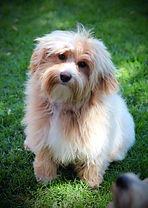Bichon ShihTzus

BabyBarks
The Ultimate Family-Friendly Companions!

Our Puppy to Adult Color Changes...

Color Change:
The color around the eyes of the puppy and the root of the hair, on the puppy's side, will give a good indication of what color your new buddy will become!
Most apricot puppies have a lot of black scattered through their coat, on their ears and around their faces. This is called "black tipping" and the majority of it will grow out and be cut away by their second haircut. Many Bichon Shih Tzus will lighten in color until 3 years of age and after that point, they can actually darken back up a bit. Some dogs change very minimally and will stay nearly the same color from puppyhood to end of life. We can give a good estimate of what color the puppy will change to during the selection process. We've had many families with past experience tell us that they find the changes exciting and whether their dog is dark or light, they are the best pets possible, so they couldn't be happier!
Solids vs. Patch Coats:
We define our dogs are "solids" or "patch coats". Many registries refer to patch coats as "partis". A patch coat has white legs with white on the belly and typically up the chest. Essentially, if you turned the dog belly up, you'd see almost all white. The patch coat will also have some white over his back. It may be a tiny bit or it may be a lot... it all depends on the dog. A solid has the color of their coat extending down their legs. They may have white socks but those socks only extend part way up the leg. The back of the dog is solid in color.
Tricolors:
Tricolor doesn't just mean "three colors". It is actually a descriptions of a specific coloration. These dogs will have a black coat with brown/gold highlights on their legs, bum, cheeks and over their eyes. Think of a Rottweiler or a Burnese Mountain Dog. This is the color pattern we're referring to, but in the Bichon Shih Tzu it can stay true thought life, fade to a silver/peuter grey or fade to white. We can typically give a good estimate whether a puppy is going to stay true or fade, and to what level it will fade.


Color and prevalence:
White seems to be the dominant color. Without careful breeding and maintenance, most family groups of Bichon Shih Tzus will predominantly produce white dogs. This is why you'll find LOTS of white Bichon Shih Tzus if you do a breed search or join a facebook group. The creation of color takes a LOT of time, effort and diligent breeding and the colors we are able to produce are a direct result of Pooch Palace's focused breeding over 35+ years. Even so, reds and dark apricots are rarer. These seems to be the most difficult color to produce and to have them occur as a "nonfading" trait is extra rare and exciting when it pops up!

Fading Tricolor
Change to gold and silver

Tricolor


Medium Apricot


White
with
Black Tipping


Light Apricot


Non fading Tricolor


Medium Apricot


Light Apricot


Dark Apricot / Red


Black and White


Light Apricot


Fading Tricolor
Change to silver
.jpg)

Fading Tricolor
Change to white



Clean Apricot
No black tipping, starts white and gets darker with age



Non fading Tricolor


Red


Light Apricot/White


Light Brindle
(becomes light apricot with black stripes)

